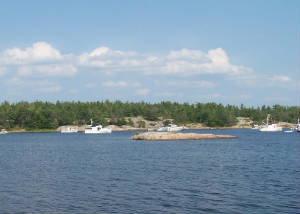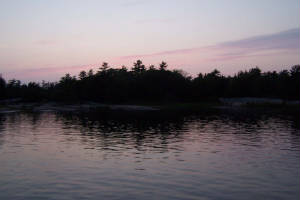|
|
 |
At the same time as this page was added -- July 17, 2005 -- we made additions to the Trent-Severn
Waterway section, now found by clicking on "Where Were We Recently?" on the bar to the right hand side of this page.
If you haven't seen our photos and write-up of Starsong's
journey over land on the only marine railway lock in the world (we think), you may want to go back to "Where
Were We Recently?" and go to Page 3 of that section to check it out.
This section has two pages. Click the link below to go to Page 2 and see some highlights from our time at Beacon
Bay Marina for the AGLCA Rondezvous.
|
 |
July 15 Chimney Bay, Beausoleil Island
We had many warnings about that care that must be taken when entering Georgian Bay from the last lock in
the Trent Severn Waterway. The channel is narrow, there is a strong current, and the markers can be confusing as
they change from red on the left in the Severn River to red on the right outside the lock.
We safely traversed that passage, then got to one of the most dreaded spots in all of Georgian Bay, Potato
Island Channel. The area looks like Paul Bunyan dropped a big sack of redskin potatoes into the bay. The channel that
snakes through the islands is none too deep, quite narrow and circuitous. But, it is well-marked, and we had no
problems slowly picking our way through.

|
| Beausoleil Island anchorage |
We decided to anchor off Beausoleil Island, the largest of the Parks Canada Islands in the Bay. We
passed along the east coast of the island to Chimney Bay, a very protected, and very popular, anchorage at the island's
north end.
We took our dinghy in to the island to explore a bit. There were several groups tent-camping on the
island's wooden platforms. We were glad to be out on our boat, rather than camping on the island, because deer
flies were buzzing about, and the woods dampened the breeze.
We took a short hike to Fairy Lake, a small inland lake lined with pikerel weed and other marsh plants that
discouraged any thoughts of jumping in to cool off. There were lots of blueberry bushes along the path, and we sampled
a few tiny sweet berries, but didn't linger because the deer flies were on the attack.

|
| Chimney Bay sunset |
Starsong was deer fly-free. We lazed aboard, periodically cooling off with dips in the clear
81 degree water. Dick couldn't resist cleaning Starsong's waterline with a scrubby while swimming around the
boat.
We shared one last cocktail hour with Summertime and Ceilidh. Tomorrow, Madonna
and Carl will continue on their way home to an island in northern Lake Superior, while Lenny, Roxanne, and we will
continue to the AGLCA Rondezvous beginning Monday in nearby Penetanguishene.
(Check out the blue box at the bottom of this page for a brief history of Beausoleil Island.)
July 16-17 Penetanguishene -- before the Rondezvous
We spent our first day at the town dock of "Port of Historic Penetanguishene." Based on an erroneous
reading of our cruising guide, we had expected to walk off the boat at the Historic Port and enter a 19th Century
British Naval Base teeming with soldiers and sailors dressed in period attire. A trip to the Chamber
of Commerce, located next to the Dockmaster's office, clarified that Discovery Harbour was, in fact, a long bike ride
away. The temperature was, once again, pushing 90 degrees, and the humidity was worthy of New Orleans, so
we passed it up. We did think about going over by dinghy, but on our way across the bay in Starsong we had
gotten tossed about violently by the wakes of fast boats heedless of their effects on others. Consequently, we
feared that venturing out in a craft as small as a dinghy on a Saturday afternoon would be suicidal, or at least unpleasant.

|
| World Famous Dock Lunch at the Historic Port |
We did visit the "World Famous Dock Lunch," a local, if not international, legend. They had a massive
condiment bar offering about twenty different choices for dressing up their burgers and hot dogs -- olives, sauerkraut,
pepper relish, all different types of pickles and pickle relishes, and tomatoes. We got burgers, fries, and onion rings,
pretty much filling our grease quota for the month. It was wonderful!
Wandering about, we learned that we were wrong about Paul Bunyan dropping the potatoes in the Bay.
It was the Huron Giant Kitchikewana who was responsible for the 83,000 charted islands in Georgian Bay. The legend goes
that when he was spurned by the princess Wanakita, in his rage he picked up a handful of earth and threw it into the
Bay, creating all the islands.

|
| Kitchikewana |
This statue which stands in a Penetanguishene park recounts the legend.
A bike and walking path runs along the waterfront for about a mile. It passes marshlands, meadow,
a lighly wooded area, and a beach. Signs along the way curate the different habitats and tell the story of how and why
this park was reclaimed.
One of the signs has a photograph of logs and wood scraps exposed when a huge windstorm swept water from
the bay and dropped the water level over three feet. The bottom was solid with wood, left from logging and sawmill
operations, and no plants grew there. They cleared out the wood in the water, returned filled areas on the shore
to their wetland state, and planted native wildflowers where lawns had been.
One of the signs explained that Canada Geese like to graze on mowed lawns, but avoid the tall grass of natural
meadows because of fear of predators, so this has helped to cut back on the number of geese hanging around making a mess
in the park.
We were fascinated by this park, and thought it was a great asset to the town.
The next day it took us less than an hour to move Starsong south down the Bay to Beacon Bay Marina,
one of the friendliest and most accomodating marinas we have visited on our cruise. They moved us from our initial
berth to a spot with better reception of their wi fi signal. They set up a haircut appointment for me, and will take
me there and back tomorrow. They have complimentary newspapers every day.
They seem very sincere in wanting to know what we need to have a perfect stay here, and they work hard to
provide it. We are very impressed.
We had planned to do some work on the boat before the Rondezvous began, but our plans were waylaid by friends
and weather. We kept running into cruising friends and having long conversations that distracted us from work.
Then, rain showers and thunderstorms started in the late afternoon, limiting options for exterior work.
We didn't get to very much of the work we had planned, but we had a very full day, and are looking
forward to the beginning of the official Rondezvous program tomorrow.
|
 |
|
|
 |
|
|
 |
|
|
|
A little Beausoleil Island History:
I thought the island was named in French for "beautiful sun," an apt description for our experience here.
Actually, it was named for a fur trader who stayed on the island in 1819.
The island has a history of human use spanning 10,000 years and twelve different cultures, but only one
community stayed here year-round. There is archaeological evidence of fishing camps, stone tool production, and
pottery formed from different colors of clay found along the shore.
In the 1830s when the first Indian Reservation in the area was established nearby, the Anishinabe came to
the island to conduct traditional ceremonies, because their traditions were being discouraged and replaced by Christian doctrine
on the Reservation. After the Reservation "experiment" failed in 1836, over 200 native people tried to establish a village
on the island, but the island could not provide enough support for them, and they left in 1856.
After they left, the island was logged, and sand and gravel were removed for local construction projects.
The park was established in 1929, and gradually since then Parks Canada has been trying to return the island to its
natural state, while providing facilities to enhance its use by boaters, campers and day visitors. Managing these
two conflicting objectives is a tricky balancing act, but we think they are doing it very well.
|
|
|
 |

